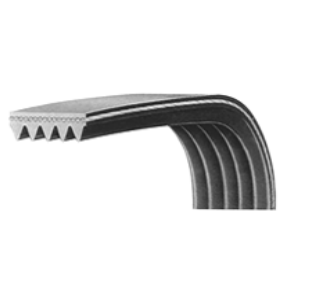
High-Performance Gear Systems | Custom Solutions for Heavy-Duty Applications
Browse our precision-engineered gearboxes, hydraulic spindles, and cast housings – designed for extreme durability, 30% longer lifespan, and seamless OEM integration.Poly-rib belts, often referred to as multi-rib belts, are a type of synchronous drive belt designed with multiple longitudinal ribs on the inner side. These ribs engage with corresponding grooves in pulleys, ensuring efficient power transmission with minimal slippage. Made from advanced polymer materials like ethylene propylene diene monomer (EPDM) rubber and reinforced with high-tensile cords, poly-rib belts offer superior flexibility, durability, and resistance to heat, oil, and abrasion. They are widely used in automotive engines, industrial machinery, and HVAC systems due to their high load capacity, quiet operation, and long service life.
Our poly-rib belts are engineered to meet international standards, such as ISO 9982 and DIN 7753, ensuring compatibility and performance across various applications. Below are the detailed specifications in a tabular format for easy reference.
| Parameter | Description | Values/Range |
|---|---|---|
| Belt Type | Number of ribs and profile designation (e.g., PK profile) | 3PK, 4PK, 5PK, 6PK, 7PK, 8PK, etc. |
| Pitch Length | Effective length measured along the pitch line of the belt | 500 mm to 2500 mm (custom lengths available) |
| Rib Pitch | Distance between the centers of adjacent ribs | 3.56 mm (for PK profiles) |
| Width | Overall width of the belt including ribs | 9.5 mm to 25 mm (depending on number of ribs) |
| Height | Thickness of the belt from top to bottom | 4.5 mm to 6.5 mm |
| Tensile Strength | Maximum load the belt can withstand without breaking | Up to 2000 N per rib |
| Operating Temperature | Range within which the belt maintains performance | -40°C to +120°C |
| Material Composition | Primary materials used in construction | EPDM rubber with polyester or aramid cord reinforcement |
| Standards Compliance | International standards met for quality assurance | ISO 9982, DIN 7753, SAE J1459 |
Poly-rib belts outperform traditional V-belts and timing belts in several ways. They offer up to 30% higher power transmission efficiency due to the multi-rib design, which increases the contact area with pulleys. This reduces slippage and energy loss. Additionally, their lightweight construction and flexibility lead to lower inertia, making them suitable for high-speed applications. Unlike chains, they operate quietly and do not require lubrication, reducing maintenance costs. The EPDM material provides excellent weather and ozone resistance, extending lifespan even in outdoor or demanding environments.
What is the difference between a poly-rib belt and a V-belt?
Poly-rib belts have multiple ribs that run parallel along the belt's length, allowing for better grip and higher power transmission in a compact form. V-belts have a trapezoidal cross-section and rely on friction on the sides, which can lead to more slippage and lower efficiency, especially in multi-drive systems.
How do I determine the correct poly-rib belt size for my application?
Measure the pitch length by calculating the circumference along the pitch line of the pulleys, or refer to the manufacturer's specifications for your machinery. The number of ribs (e.g., 6PK) should match the pulley grooves. Always consult compatibility charts or a professional to ensure proper fit and performance.
Can poly-rib belts be used in high-temperature environments?
Yes, poly-rib belts made from EPDM rubber can withstand temperatures from -40°C to +120°C, making them suitable for engine compartments and industrial settings. For extreme temperatures beyond this range, special heat-resistant compounds may be available.
How often should poly-rib belts be replaced?
Replacement intervals depend on usage conditions, but typically, inspect belts every 50,000 to 100,000 kilometers in vehicles or annually in industrial equipment. Look for signs of wear such as cracking, glazing, or rib deformation, and replace if any damage is detected to prevent failure.
Are poly-rib belts resistant to oil and chemicals?
Yes, the EPDM material used in high-quality poly-rib belts offers excellent resistance to oils, chemicals, and moisture. This makes them ideal for automotive and industrial applications where exposure to lubricants or harsh substances is common.
What causes poly-rib belts to squeal or make noise?
Squealing usually indicates slippage, which can be caused by improper tension, worn pulleys, or contamination like oil on the belt surface. Ensure correct tensioning using a tension gauge, clean the pulleys, and inspect for alignment issues to resolve noise problems.
Can I repair a damaged poly-rib belt, or should it always be replaced?
Poly-rib belts should always be replaced if damaged, as repairs are not reliable and can lead to sudden failure. Damage such as cuts, missing ribs, or severe cracking compromises integrity and safety.
Do poly-rib belts require any special maintenance?
They are low-maintenance; regularly check for tension, wear, and alignment. Avoid over-tightening, which can cause premature wear, and keep the belt and pulleys clean from debris. No lubrication is needed, as it can attract dirt and reduce grip.
How do environmental factors affect poly-rib belt performance?
Extreme cold can make belts stiff temporarily, but EPDM materials quickly regain flexibility. UV exposure, ozone, and humidity are well-tolerated, but prolonged direct sunlight may degrade the rubber over time. Store belts in a cool, dry place when not in use.
Are there eco-friendly options for poly-rib belts?
Yes, some manufacturers offer belts made from recycled materials or designed for longer life to reduce waste. EPDM is also a durable material that minimizes replacement frequency, contributing to lower environmental impact compared to less efficient alternatives.

Copyright © Raydafon Technology Group Co.,Limited All Rights Reserved.